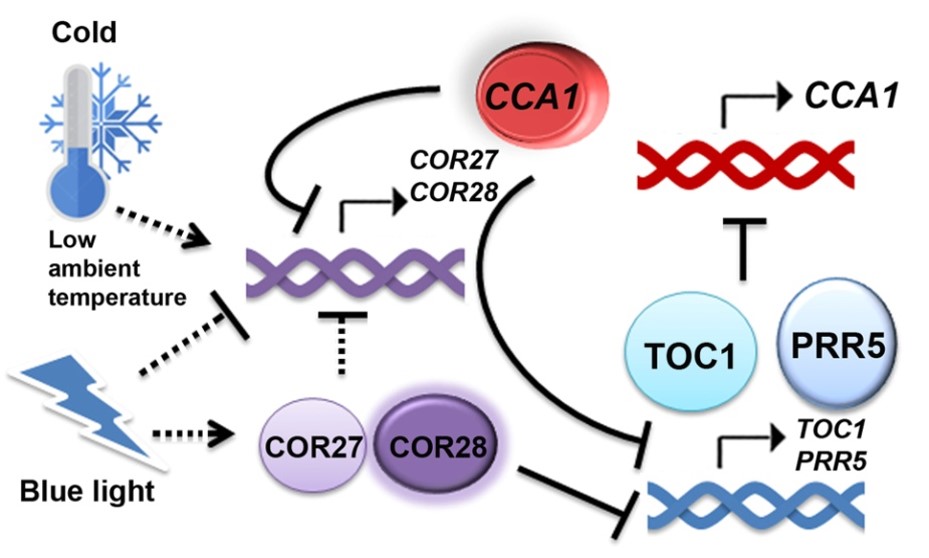Scientists Reveal the Mechanism by which Circadian Clock is Regulated by Environmental Cues in Plants
The circadian clock is an evolutionarily conserved, endogenous time-keeping mechanism that maintains rhythmic oscillations with periods of approximately 24 hours. It functions by synchronizing metabolic and developmental processes to environmental cues, thereby improving the fitness of bacteria, fungi, plants and animals. It has been known for decades that blue light and temperature are two key environmental signals that profoundly affect plant circadian clock, but underlying molecular mechanisms are largely unknown.
A research group led by Dr. Hongtao LIU at the Institute of Plant Physiology and Ecology, CAS Center for Excellence in Molecular Plant Sciences, addresses the question how blue light regulates the circadian clock in coordination with temperature in the model plant Arabidopsis thaliana.
COLD-REGULATED GENE 27 (COR27), COLD-REGULATED GENE 28 (COR28) were identified as cold-responsive genes from Arabidopsis transcriptome profiling. Dr. Hongtao LIU and her colleagues demonstrate that the abundance of COR27 and COR28 are regulated by not only low temperatures but also light signals. COR27 and COR28 are involved in regulating period length in the circadian clock and they associate with chromatin regions of PRR5 and TOC1 to regulate their transcription, suggesting that their effects on rhythms are in part due to their regulation of TOC1 and PRR5. Furthermore, COR27 and COR28 are negative regulators of freezing tolerance but positive regulators of flowering, possibly representing a trade-off between freezing tolerance and flowering. These data collectively reveal that COR27 and COR28 act as an integrating hub between blue light and low temperature and plays critical roles in circadian clock as well as freezing tolerance and flowering time.
This work entitled “Blue Light and Low Temperature-Regulated COR27 and COR28 Play Roles in the Arabidopsis Circadian Clock” has been published online in The Plant Cell on November 11st.
The research was funded by NSFC and CAS.
CONTACT:
Hongtao LIU, Ph.D., Principal Investigator
National Key Laboratory of Plant Molecular Genetics, CAS Center for Excellence in Molecular Plant Sciences, Institute of Plant Physiology and Ecology, Chinese Academy of Sciences, Shanghai 200032, China
Tel: 86-21-5494291
Fax: 86-21-54924015
E-mail:
htliu@sibs.ac.cn A Hypothetical Model Depicting Light- and Low Temperature-Regulated COR27 and COR28 Play Roles in the Circadian Clock.
A Hypothetical Model Depicting Light- and Low Temperature-Regulated COR27 and COR28 Play Roles in the Circadian Clock.
The model hypothesizes that the transcription of COR27 and COR28 is induced by cold / low ambient temperature but repressed by blue light, and their protein are stabilized in response to blue light, they repress the transcription of TOC1 and PRR5, then to affect the period length of the circadian clock, in the mean time, they are regulated by the circadian clock, CCA1 represses the transcription of COR27 and COR28 though direct promoter binding.
 A Hypothetical Model Depicting Light- and Low Temperature-Regulated COR27 and COR28 Play Roles in the Circadian Clock.
A Hypothetical Model Depicting Light- and Low Temperature-Regulated COR27 and COR28 Play Roles in the Circadian Clock.